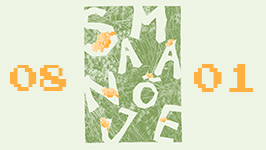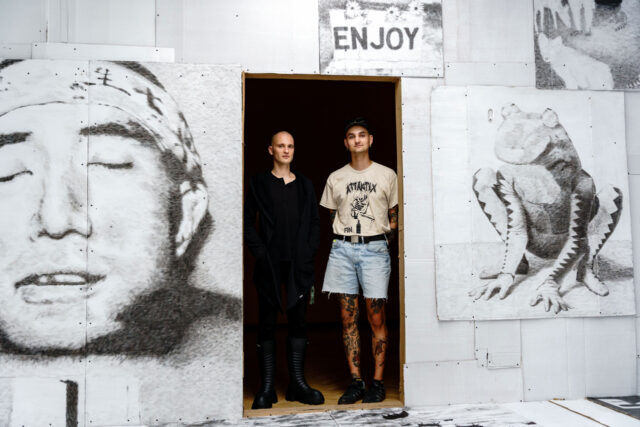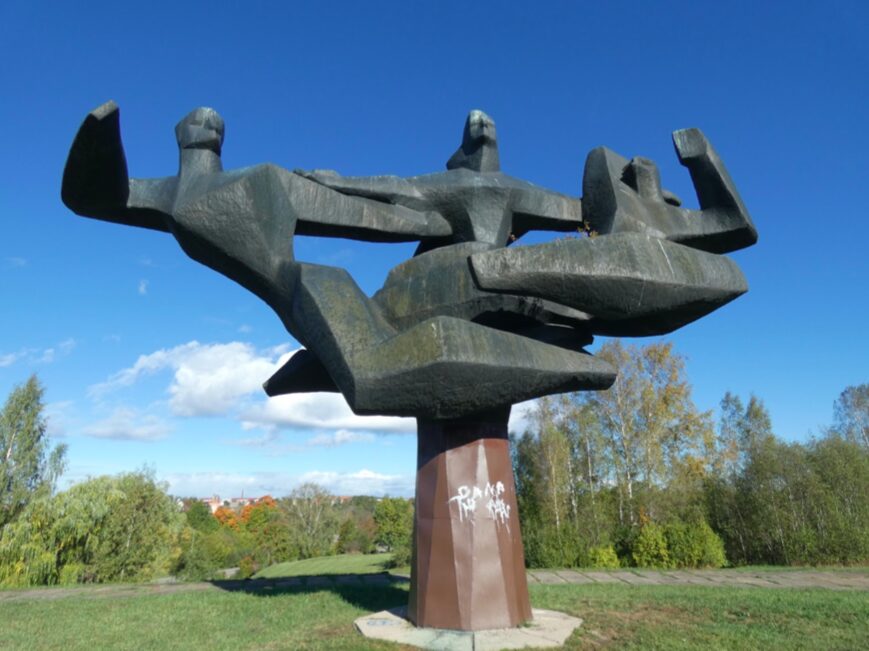On the 7th of April, the Vilnius Academy of Art invited visitors to “Whirlpools”, an exhibition of four young female artists located in the exhibition hall “Titanikas” (ground floor).
This is the second part of the ongoing project “Is She Coming?”, led by curator and artist Laura Stasiulytė, which presents the works of emerging Lithuanian artists, all of whom have studied at the Photography and Media Arts department at the VAA. The first exhibition took place at the KCCC exhibition hall in Klaipėda in 2020, but it has since evolved. Now, the same artists are presenting their creative developments in a completely different environment.
The exhibition presents objects that unravel events. There are various bits, pieces, parts and elements. They are inherent to movement and are a part of the objects themselves: of the malleable and restless, the breathing, floating, melting, swirling, fluttering or incandescing. The artists’ inspirations and topics come from everyday life: from water, inter-corporeity, technology, texts, desires, anxiety, angst and imagination.
One can meet some odd creatures lurking around Agnė Masilionytė’s “Valley”, a ghostly brood of digital “half-breeds” trapped within a screen, born from reality’s artefacts and the artist’s imagination. A one-winged butterfly has fluttered in from the oil fuel cemetery at the Kalgraužiai forest; a coral-like bush captured by the Google car quivers somewhere, covered with leftover rubbish from someone’s carnal pleasures; a plastic-legged entity slowly crawls by, cast from the sea and dug out of the sand by Agnė herself; a “kitten” of a budding willow in spring is breathing nearby.
Austėja Masliukaitė’s “I Don’t Want It Anymore” materializes from the contemplation of desires and the plasticity of matter. If one managed to lick through the gold, silver would be discovered; if time was overcome, only beeswax softening in one’s hands would remain. A half-eaten lollipop signifies an interruption of pleasurable actions, a simultaneous moment of dissolution and hardening. In “Variations in Gyre”, Austėja’s non-verbal vocals travel in all possible directions around the exhibition and between the artworks, devices, visitors and the gallery infrastructure itself. The artist’s voice acts as a wave-inducing acoustic router.
Saulė Miežytė’s “Melanin Print” originates from a beauty sunbed, whose blue UV lamps darken our skin. The “greenhouse” of lights suggests that one should take a walk around. Sunglasses, reminiscent of an analog photographic film, protect the eyes from the UV and invite one to observe multiple solar eclipses. It is a futuristic fantasy about the times when our own personalised suns will be set in our smart homes, about new types of photosynthesis, therapies and devices that kill bacteria or generate supplements.
In Aistė Marija Stenkevičiūtė’s “Ears Lick Lips”, an empty ankle cast suggests a failure to leap through the puddles, while the pupil of a cuttlefish signifies a separation from the eyelid. Its W shape shows that it is ready to wiggle in all directions in a single blink of its eye – back to the waters or to the bookshelf. The whiskers turn from the heating stoves. Yet it couldn’t handle the temperature, and the glass melted and flowed into black puddles. A rolling dice of non-soluble soap creates new combinations of direction: ears lick lips and thrust into the hot air as an imminent fulfilment of a promise.
Whirlpools have their geometry wherein the vertical axis intertwines with the horizontal – they can move, stretch, turn and interact in a complex manner. They pull in and concentrate almost everything, without “turning their head”, they don’t select but produce new combinations and encounters – just as a blender turns fruit into a bubbling smoothie, as a spa’s hot tub pulls in unfamiliar bodies, or as a standing plane’s gyre sucks water and pebbles into the plane or the engine itself. A whirlpool can swirl inside a different one: a number of whirlpools, almost parallel to one another and circulating in the same direction, attract one another and finally coalesce.
Circles are lines that constantly deviate from themselves. (T. Morton)
Artists: Agnė Masilionytė, Austėja Masliukaitė, Saulė Miežytė, Aistė Marija Stankevičiūtė
Curator: Laura Stasiulytė Gudaitė
Architect: Vladas Suncovas
Exhibition hall Titanikas
Exhibition is open until the 23rd of April.
Photography: Laurynas Skeisgiela
Video: Jurgis Dudėnas

Agnė Masilionytė, Valley, 2020

Agnė Masilionytė, Valley, 2020

Agnė Masilionytė, Valley, 2020

Agnė Masilionytė, Valley, 2020

Agnė Masilionytė, Valley, 2020

Agnė Masilionytė, Valley, 2020

Agnė Masilionytė, Valley, 2020

Aistė Marija Stenkevičiūtė, Ears Lick Lips, 2020

Aistė Marija Stenkevičiūtė, Ears Lick Lips, 2020

Aistė Marija Stenkevičiūtė, Ears Lick Lips, 2020

Aistė Marija Stenkevičiūtė, Ears Lick Lips, 2020

Aistė Marija Stenkevičiūtė, Ears Lick Lips, 2020

Austėja Masliukaitė, I Don’t Want It Anymore, 2020

Agnė Masilionytė, Valley, 2020

Exhibition view

Saulė Miežytė, Melanin Print, 2019

Saulė Miežytė, Melanin Print, 2019




























